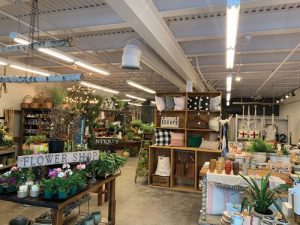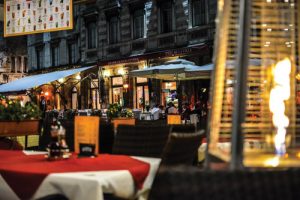— By Tim Blanchard —
The impact of LED lighting in retail facilities.
Without a doubt, it’s important for retail facilities to maintain a well-kept and organized store to guarantee a positive environment for customers. The overall environment should be aesthetically pleasing as it has the potential to make or break the customer’s experience. With the many factors that contribute to an overall pleasant environment, a pertinent one is lighting.

Tim Blanchard, Energy Source
As it is, retail facilities can be quite costly to maintain. Due to the cost savings as well as the added health and safety benefits provided, many retail facilities are making the switch to LED technologies. Through the implementation of LEDs, retail facilities can improve the well-being of customers and staff, while also saving more money in the long run. To start, a simple switch to LEDs from inefficient traditional technologies like fluorescent and metal halide lighting can provide a reduction in energy consumption of more than 50%. LED smart fixtures and controls can help stores customize their lighting needs and reduce energy usage by an additional 10%, giving retailers a baseline of guaranteed savings to build off of while simultaneously providing higher quality lighting for customers.
The Impact of Lighting
Implementing LEDs could positively impact individuals in a number of ways. According to a study from the University of Toronto Scarborough, human emotion is felt more intensely with bright lights involved. Because of this intense emotion and feeling, lighting has the potential to benefit particular environments where individuals are making decisions about what they want to purchase and what they don’t.
 While we’re often familiar with the emotion felt surrounding the lighting displays around the holidays, there are simple adjustments in LED lighting that retailers can use on the floor every day to create a positive shopping experience for customers. For example, in retail facilities, lighting output can be increased, or the color of the LED diodes can be manipulated in different sections of the store. This can help direct focus to displays and even lead customers to sections within the store that are hosting specials or promoting specific products that the store needs to push.
While we’re often familiar with the emotion felt surrounding the lighting displays around the holidays, there are simple adjustments in LED lighting that retailers can use on the floor every day to create a positive shopping experience for customers. For example, in retail facilities, lighting output can be increased, or the color of the LED diodes can be manipulated in different sections of the store. This can help direct focus to displays and even lead customers to sections within the store that are hosting specials or promoting specific products that the store needs to push.
Furthermore, lighting can impact us biologically which is why it’s critical to find the optimal balance between light output and correlated color temperature. Studies have shown that 6,000K-8,000K LEDs consisting of a blue spectral focus have the best biological impact, while 3,000K-5,000K LEDs and those closer to ‘daylight white’ were found to be the most visually appealing. To minimize eye strain while still promoting consumer health, retail facilities can adjust their lighting to find their ideal compromise between biological impact and overall comfort levels.
More Efficient Energy Management with Controls and Automation
There are a number of different options for LED controls, as networking and IoT through smart fixtures further advance retailers’ smart lighting capabilities. On the simpler side of controls, occupancy sensors are a common option that is used within small and large facilities alike. Commonly used with LEDs in areas of the store that receive less traffic, such as stock rooms, these sensors can minimize wasteful energy use when the store is active but certain rooms, such as storage or stock rooms, are not in use. Timers for LED lights across the entire store floor are another option that facilities often turn to as they can be pre-set to turn on and off based on store hours. Controls can also become more complex depending on the store’s specific needs. For example, some storefronts may use controls for daylighting, which uses sensors to identify how much natural light is coming into the store and adjusts light output accordingly. Controls for networked lighting can span across an entire store giving commands to all fixtures or can be adjusted to only impact select smart fixtures for more precise and tailored energy use.
 While sensors and controls are important for inside the store, they are just as important for outside the retail facility, particularly in parking garages. Throughout walkways, garages and parking lots, LEDs provide a brighter, safer, and cleaner experience. Depending on the time and how far the parking garage is, LED controls can ensure that outdoor areas remain well-lit, either through pre-set timers or sensors that turn LED lighting on when it starts to get dark outside. This helps to provide an environment customers and staff feel comfortable in as high-quality lighting can increase the feeling of safety, particularly at nighttime.
While sensors and controls are important for inside the store, they are just as important for outside the retail facility, particularly in parking garages. Throughout walkways, garages and parking lots, LEDs provide a brighter, safer, and cleaner experience. Depending on the time and how far the parking garage is, LED controls can ensure that outdoor areas remain well-lit, either through pre-set timers or sensors that turn LED lighting on when it starts to get dark outside. This helps to provide an environment customers and staff feel comfortable in as high-quality lighting can increase the feeling of safety, particularly at nighttime.
The Benefits of LEDs and Beyond
Retail facilities often require a significant amount of energy and maintenance to support a positive and safe environment. LEDs and smart fixtures offer a number of maintenance benefits that lead to further savings beyond energy costs.
LEDs have a significantly longer lifespan than traditional fluorescents or metal halide solutions, often reaching up to 100,000 hours with very little reduction in light output or lumen maintenance over time. This means fewer replacements are needed to maintain a well-lit environment for shoppers and maintenance staff can focus on other areas of the store that need attention. Simultaneously, many LED providers will offer a 10-year warranty that ensures your lighting will last for at least a decade, again reducing costs for both maintenance and replacements. The durable construction LEDs further supports safety for shoppers as the glass-free, mercury-free design provides fewer breakage and safety risks.
Overall, LEDs have the potential to positively impact customer’s and help retail facilities achieve a clean, organized, and positive environment that customers and staff members deserve. The material, durability, lifespan, and controls aspect can improve this experience and cause less maintenance in the long run for facility managers.
— Tim Blanchard is CEO at Energy Source, a division of Revolution Lighting Technologies. For more information, visit www.energysource.com.
